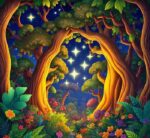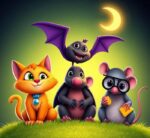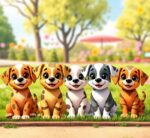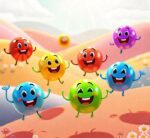- You are here:
- Home »
- words
- » Halloween Words That Start With M [LIST]
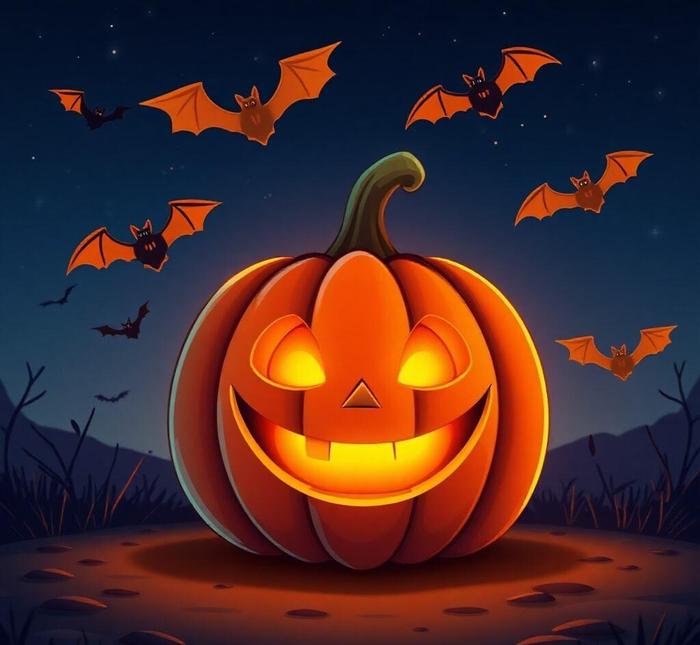
Halloween Words That Start With M [LIST]
Halloween is a time of spooky fun, and language plays a big part in setting the eerie mood. Whether you’re getting ready to decorate, plan a costume, or just want to add some festive flair to your celebrations, knowing Halloween-related words can help elevate the experience. In this article, we’ve compiled a list of Halloween words that start with the letter “M”, offering a mix of creepy, mysterious, and magical terms that will make your Halloween vocabulary as haunting as the season itself. From classic monsters to mythical creatures, these words are sure to inspire some eerie creativity.
The letter ‘M’ brings to mind a variety of themes associated with Halloween-think of witches brewing potions, midnight spells, and monstrous creatures lurking in the shadows. Many of these words evoke feelings of fear and excitement, enhancing the spooky atmosphere of the holiday. Whether you’re searching for a theme for a Halloween party, brainstorming a costume idea, or simply expanding your spooky lexicon, these ‘M’ words are the perfect addition to your Halloween vocabulary list.
Halloween Words That Start With M
1. Mummy
A mummy is a preserved body, often associated with ancient Egypt, wrapped in bandages and commonly depicted in horror stories as coming back to life as a vengeful spirit. Mummies are a staple of Halloween, often featured in decorations, costumes, and themed events.
Examples
- The mummy, wrapped in ancient linen bandages, was one of the most iconic creatures in Egyptian mythology.
- At the Halloween party, there was a spooky mummy costume that frightened all the guests.
- In the movie, the cursed mummy awakens after being disturbed by archaeologists in an ancient tomb.
2. Moon
The moon has long been associated with mystery and the supernatural, especially around Halloween. In folklore, a full moon is often connected with creatures like werewolves, and its glow adds a haunting ambiance to nighttime festivities.
Examples
- On Halloween night, the full moon illuminated the sky, casting eerie shadows across the landscape.
- The werewolf howled at the glowing moon, its transformation now complete.
- They told ghost stories under the light of the harvest moon, creating a perfect spooky atmosphere.
3. Monster
A monster is a large, frightening creature often featured in horror films, books, and Halloween decorations. Monsters can be anything from supernatural beings to grotesque mutants, often evoking fear and fascination during the spooky season.
Examples
- The children dressed up as classic monsters like Dracula, Frankenstein, and the Werewolf for Halloween.
- A huge, terrifying monster lurked in the dark woods, its eyes glowing red as it searched for prey.
- Monster movies, with their terrifying creatures, have been a Halloween tradition for generations.
4. Mask
A mask is an item worn to cover the face, often used during Halloween to disguise one’s identity. Masks are a staple in costumes, ranging from scary creatures to mysterious characters, and they add an element of suspense and thrill to Halloween festivities.
Examples
- She wore a creepy, clown mask that made everyone at the party shudder with unease.
- The vampire’s mask was intricately designed, with sharp fangs painted onto the lips.
- A mask can completely transform someone into a different persona, which is why they’re so popular on Halloween.
5. Madness
Madness refers to a state of mental instability or irrational behavior, often depicted in horror stories and Halloween lore. It is commonly used to describe the psychological breakdown of characters, especially in haunted or cursed environments.
Examples
- The madness of the Halloween night was palpable, with everyone reveling in the eerie atmosphere.
- In the haunted house, the guests slowly descended into madness, surrounded by unsettling sights and sounds.
- The witch’s curse caused madness to spread through the village, turning everyone into frantic, wild-eyed creatures.
6. Magician
A magician is a person skilled in performing illusions, tricks, and feats of magic. In the context of Halloween, magicians are often depicted as mysterious figures who wield dark powers, creating an atmosphere of suspense and wonder.
Examples
- The magician performed a series of spooky tricks, pulling a black cat from his hat and making a skull float in mid-air.
- A magician’s costume with a dark twist, complete with a sinister hat and glowing eyes, was a popular choice this Halloween.
- As the magician waved his wand, the room filled with eerie fog, and a phantom appeared to the audience’s delight.
7. Macabre
Macabre refers to something that is gruesome, horrifying, or related to death. In Halloween settings, the macabre often describes imagery or themes that deal with death, decay, and the sinister, creating a chilling mood.
Examples
- The macabre decorations in the haunted house included dismembered limbs and skulls.
- He loved the macabre tales of ghosts and murders, finding beauty in the horror of it all.
- The film’s macabre atmosphere was heightened by its eerie soundtracks and unsettling visuals.
8. Moonlight
Moonlight refers to the light emitted by the moon, often used in literature and films to enhance eerie or supernatural atmospheres. In Halloween tales, moonlight creates an otherworldly glow, often seen illuminating haunted places or creatures lurking in the night.
Examples
- The moonlight bathed the graveyard in an ethereal glow, making the tombstones appear even more ominous.
- Under the moonlight, the witch’s silhouette was barely visible, casting a long shadow on the ground.
- The ghostly figures in the forest seemed to vanish into the moonlight, as if they were never really there.
9. Mischief
Mischief refers to playful, often slightly troublesome behavior, especially during Halloween. It’s commonly associated with trick-or-treating antics, where children engage in harmless pranks or tricks, adding a sense of playful chaos to the holiday.
Examples
- The mischievous goblins played pranks on unsuspecting trick-or-treaters, stealing candy and hiding behind bushes.
- On Halloween night, the kids were full of mischief, sneaking up on each other in ghostly costumes.
- A little mischief is part of the fun on Halloween, but don’t take it too far, or you might end up in trouble!
10. Morgue
A morgue is a place where bodies are stored, usually after death, often associated with crime scenes or post-mortem investigations. It is a common setting in Halloween horror stories and films, evoking feelings of death and mystery.
Examples
- The morgue was a chilling place, with the bodies of the dead lying on cold metal tables, their faces pale and lifeless.
- In the horror story, the detective found a mysterious note in the morgue, leading him to a hidden secret.
- The morgue became the setting for a terrifying Halloween event where guests could explore and uncover eerie clues.
11. Manticore
A manticore is a legendary creature from Persian mythology, often described as having the body of a lion, a human head, and a tail that could shoot poisonous spines. This terrifying beast is occasionally featured in Halloween themes, representing the monstrous and the mythical.
Examples
- The manticore, a mythical beast with the body of a lion, the tail of a scorpion, and the face of a human, was a fearsome creature in ancient folklore.
- A dark shadow passed by as the manticore lurked in the forest, its piercing eyes glowing in the darkness.
- The Halloween haunted house featured a terrifying manticore prop that sent shivers down everyone’s spine.
12. Mausoleum
A mausoleum is a large, stately tomb or building that houses the deceased, often with elaborate architecture. In Halloween lore, mausoleums are seen as places of mystery and horror, frequently associated with hauntings or the undead.
Examples
- The old mausoleum stood in the center of the cemetery, its dark stone walls weathered by centuries of time.
- Inside the mausoleum, a hidden passage led to an ancient crypt, said to be the resting place of a cursed nobleman.
- The Halloween tour guide led visitors to the mausoleum, where they recounted tales of restless spirits trapped within.
13. Murder
Murder is the unlawful killing of someone, often used in Halloween-themed stories and events to create suspense and horror. Many Halloween games and mysteries center around solving a fictional murder, adding an element of crime and terror to the festivities.
Examples
- The mystery Halloween party revolved around solving a fictional murder that took place at an old manor.
- Legend had it that the old mansion was cursed after a gruesome murder occurred there many years ago.
- The detective had to unravel the clues surrounding a murder that happened on Halloween night, with everyone being a suspect.
14. Moss
Moss is a small, green plant that thrives in moist, shady areas, often creating an atmospheric, age-old look in Halloween settings. Its presence on old stones or tombs enhances the feeling of decay and neglect, evoking a sense of the supernatural.
Examples
- The ancient tomb was covered in thick layers of moss, making it look even older and more haunted.
- Moss hung from the trees like ghostly tendrils, swaying in the wind as if alive.
- The eerie path through the forest was lined with moss-covered stones, leading to an abandoned cemetery.
15. Maleficent
Maleficent is a fictional character, famously portrayed as a wicked fairy who uses dark magic to cast curses. Her character has become iconic in Halloween celebrations, representing dark sorcery and evil forces, especially in costumes and themed events.
Examples
- The villain in the Halloween tale, Maleficent, cast a powerful curse that sent the kingdom into eternal darkness.
- The queen’s Maleficent costume, complete with horns and a dark robe, was the talk of the Halloween ball.
- In the Disney movie, Maleficent’s dark magic turned the beautiful princess into a cursed figure, bound by the spell of eternal sleep.
Historical Context

The celebration of Halloween, as we know it today, is a confluence of ancient Celtic traditions, medieval Christian customs, and modern-day popular culture. Among the many symbols and elements that populate this eerie holiday, words and terms carry a certain mystique, connecting the past with the present. Some of the most intriguing Halloween-related terms begin with the letter "M," each steeped in history, legend, and transformation.
One of the most prominent figures in Halloween lore is the mummy, which evokes images of ancient Egypt and its burial practices. The mummy has become a symbol of the undead and is typically associated with curses and the reanimation of the long-dead. While the mummification process itself has roots in Egypt as early as 3500 BCE, it was the Western fascination with Egyptian artifacts and culture during the 19th and early 20th centuries that linked the mummy to horror themes. Stories like the 1932 film The Mummy cemented its place in Halloween traditions.
Other Halloween words starting with "M" reflect both historical practices and medieval beliefs. The term mask is central to Halloween celebrations. Masks have been used for millennia during rituals and festivals, not only to disguise one’s identity but to invoke protection or transform into a different being. In Celtic Samhain festivals, people wore masks to ward off spirits and, in some cases, embody them. These masks created a liminal space where the dead could walk among the living, blurring the lines between the two realms, a key feature of Halloween’s otherworldly atmosphere.
Likewise, the word magic often comes into play during Halloween, evoking the supernatural and the mysterious arts. Rooted in ancient traditions, magic was once a serious practice that intertwined with religious and cultural beliefs. In medieval Europe, magic was considered a powerful force, often associated with witches, whose activities were seen as malevolent or protective, depending on the perspective. The practice of witchcraft became inextricably linked with Halloween’s origins, when communities believed that the boundary between the human world and the spirit world thinned, enabling magical forces to manifest.
Word Origins And Etymology
Delving into the etymology of Halloween-related words beginning with the letter "M" offers a fascinating glimpse into how language evolves and carries traces of the past. Many of these words have traveled through centuries and across cultures, acquiring new meanings, connotations, and connections along the way.
Take, for instance, the word mummy. The English word "mummy" is derived from the Arabic term mummiya, which referred to bitumen, a tar-like substance used in the embalming process. This word itself came from the Persian mumiya, meaning "wax" or "bitumen," which was later linked to the embalmed remains of the dead. The idea of mummies being wrapped in linen and preserved with resin became a cultural hallmark, especially during the 18th and 19th centuries, when European interest in Egyptology surged. While ancient Egyptians were responsible for the practice of mummification, it was this external fascination with their culture that tied the mummy to Halloween lore.
Similarly, mask comes from the Old French word masque, which means "a face covering" or "a disguise." This word can be traced back further to the Italian maschera and the Arabic mukhah, both referring to a face or covering. In the context of Halloween, masks are essential for disguising oneself as supernatural beings, whether ghosts, witches, or monsters. The word’s evolution reflects the enduring human desire to obscure identity, especially in rituals designed to confront or protect oneself from unseen forces.
Magic, another word often associated with Halloween, has its roots in the Greek magike, referring to the craft or practices of magicians. The word magos, meaning "a sorcerer or magician," came to be associated with individuals thought to wield supernatural powers, particularly those who defied traditional religious practices. Over time, magic became synonymous with the occult, a theme that continues to pervade Halloween as it taps into the allure of the unknown, the mystical, and the forbidden.
Common Misconceptions
Despite their rich history and nuanced meanings, many Halloween words starting with "M" are surrounded by misconceptions. These misunderstandings often stem from how Halloween has been commercialized or sensationalized in modern times, causing certain words to take on meanings that differ from their original significance.
Take mummy, for example. While contemporary portrayals often depict mummies as reanimated monsters, the historical reality of mummification was far more intricate and spiritually significant. Ancient Egyptians believed that preserving the body through mummification would ensure that the soul had a safe journey to the afterlife. The modern image of the mummy as a vengeful undead creature, however, is largely a product of pop culture, beginning with films and literature. This transformation obscures the spiritual and cultural practices that mummification was originally meant to uphold.
Another word that is frequently misunderstood is mask. While masks today are often seen as a fun accessory or a way to create a spooky costume for Halloween, they originally served much more significant ritualistic purposes. In ancient cultures, masks were worn not only to celebrate but also to protect oneself from evil spirits or to transform into another being, such as an animal or deity. In medieval Europe, masks were integral to mystery plays and other dramatic performances, where they symbolized different characters or supernatural forces. The idea of wearing a mask on Halloween was rooted in these ancient rituals, but in modern times, it is often reduced to mere entertainment or a way to create a disguise.
Finally, the word magic is frequently misunderstood as something purely fictional or supernatural in the Halloween context, often associated with the whimsical and playful aspects of the holiday. However, magic once had much more serious connotations, linked to ancient practices of divination, healing, and even witchcraft. The "magic" of Halloween, with its spells, potions, and incantations, is often reduced to a simple form of entertainment or fantasy, losing the depth of its historical and cultural significance as a potent force believed to manipulate natural laws or communicate with the supernatural.
Conclusion
Halloween words that begin with the letter "M" are rich in history, myth, and transformation. Words like mummy, mask, and magic serve as bridges connecting us to the past, reflecting ancient beliefs and practices that have evolved over time. Understanding the historical context and etymology behind these words allows us to appreciate the depth and complexity of Halloween traditions, offering insights into how cultures have engaged with the supernatural, the mysterious, and the unseen.
While common misconceptions may simplify or distort these words’ original meanings, they still hold a deep connection to the world of the dead, the mystical, and the magical. Halloween is not only a time for costumes, trick-or-treating, and spooky fun—it is a celebration of the ancient and mysterious forces that have shaped human history. By reflecting on the origins and true significance of these words, we enrich our understanding of Halloween and the deep-rooted cultural traditions that continue to shape it today.

